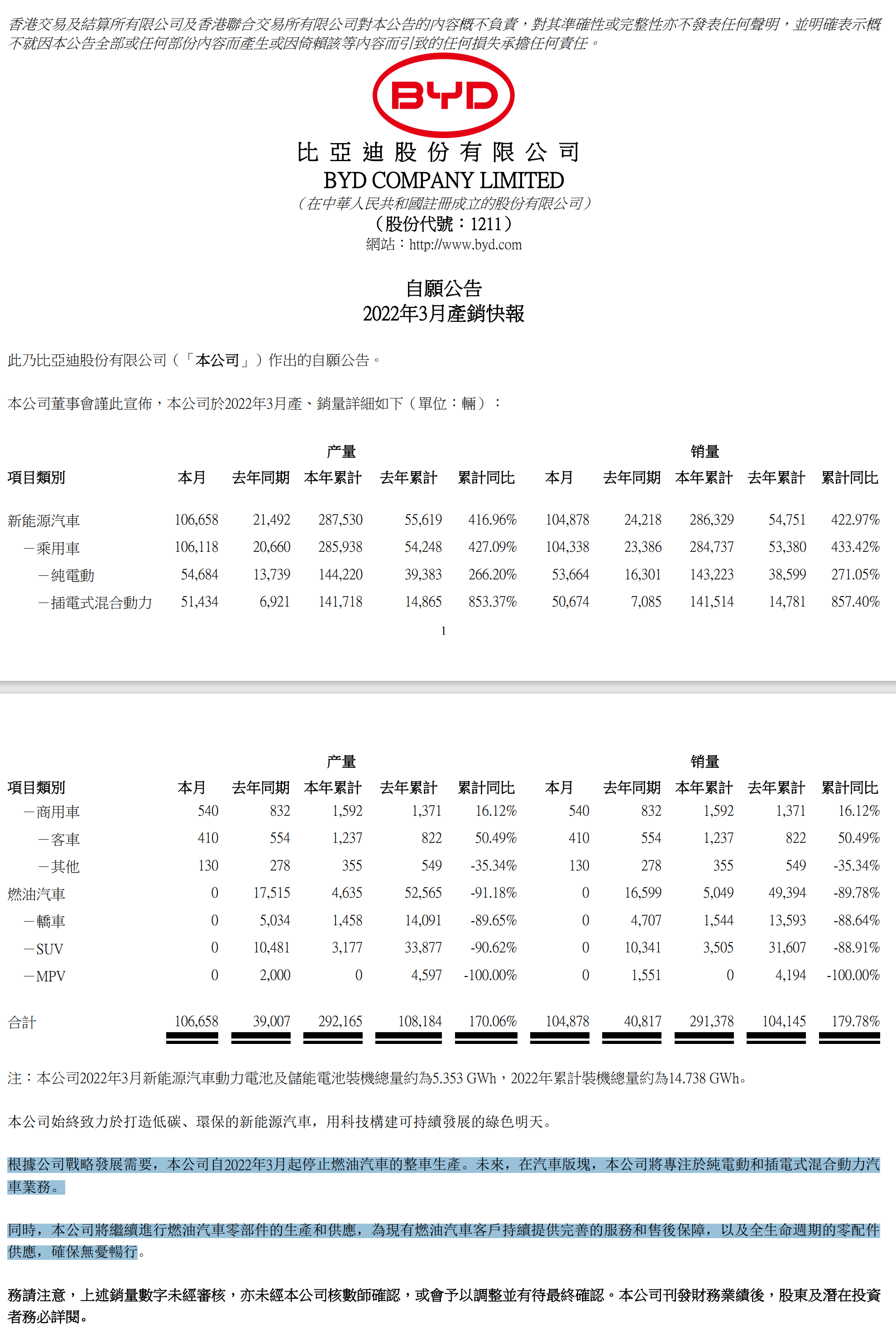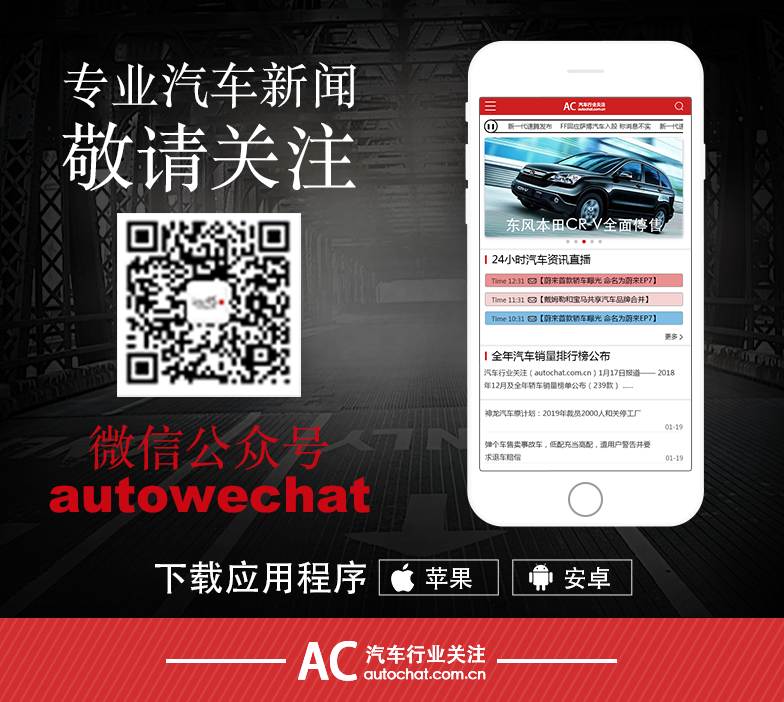In addition to Weibo, there is also WeChat
Please pay attention

WeChat public account
AutoBeta


2024-09-08 Update From: AutoBeta autobeta NAV: AutoBeta > News >
Share
AutoBeta(AutoBeta.net)04/03 Report--
On April 3, BYD Co., Ltd.(hereinafter referred to as "BYD") released the latest sales report on the Hong Kong Stock Exchange. According to the data, BYD's automobile sales volume in March 2022 was 104,878, up 156.9% from 40,817 in the same period of 2021, among which the sales volume of new energy passenger vehicles was 104,338, up 345.2% from 23,386 in the same period of 2021. The sales volume of fuel vehicles including cars, SUV and MPV was 0.

In the announcement, BYD announced that according to the strategic development needs of the company, the company will stop the production of fuel vehicles since March 2022. In the future, in the automotive sector, the company will focus on pure electric and plug-in hybrid vehicles. At the same time, the company will continue to carry out the production and supply of fuel automobile parts, and continue to provide perfect service and after-sales guarantee for existing fuel automobile customers, as well as the supply of spare parts throughout the life cycle to ensure worry-free operation.
In fact, BYD announced its withdrawal from the fuel car market or expected. As early as June 2021, the market circulated a BYD internal communication meeting minutes, which the minutes of the meeting content is: "The future of the company's fuel vehicles will not be completely replaced by DMI, DMP, stop production", and BYD replied,"This year's internal sales of fuel vehicles are expected to be around 150,000 vehicles, and the planning of future fuel vehicles has also stopped, and the fastest replacement next year (as long as DMI monthly production capacity reaches 80,000 vehicles, monthly shipments 40,000 vehicles). However, in response to the minutes of the meeting, BYD responded at that time that "there is no such plan at present, there is demand from the market and consumers at present, and there is demand from partner dealers."

According to the minutes of the meeting transmitted online, BYD has actually reached the level of replacing fuel vehicles with new energy vehicles. Since the second half of 2021, BYD's sales volume of new energy vehicles has begun to grow steadily, while the share of fuel vehicles is gradually decreasing. It can be seen more or less that BYD is promoting new energy vehicles to replace fuel vehicles. From the product point of view, since BYD's newly launched Qin PLUS DM-i, Song PLUS DM-i, Tang DM-i and other DM-i super hybrid models have been widely sought after by the market, due to limited production capacity, the market continues to be in short supply. BYD supplies limited chips and parts to hot-selling new energy vehicle products, so it seems inevitable to stop production of fuel vehicles. Before this, the automobile industry paid attention to many reports, that is, BYD will not announce the suspension of fuel vehicles in the short term, BYD will not launch brand-new fuel vehicles in the future, because it takes at least three years for a brand-new model to be launched to the market, and the current development direction of the automobile market is very clear, basically no automobile enterprises will choose to develop brand-new fuel vehicles at this time. At present, a number of automobile enterprises have announced the timetable for stopping the sale of fuel vehicles, that is, some automobile enterprises have not yet announced, but under the trend of globalization, the transformation of fuel vehicles to new energy vehicles has become an inevitable trend, and which hybrid secondary choice is the transition product between the two.
In November 2021, at the COP26 climate change conference in Glasgow, Scotland, automakers, countries and even cities were asked to commit to phasing out fossil-fuel-powered vehicles by 2040, and the automakers who signed the agreement included BYD. According to the statement, six car companies, including Volvo, Ford, GM, Mercedes-Benz, BYD and Jaguar Land Rover, signed commitments at the Climate Conference in Glasgow to achieve zero emissions for all new cars and trucks worldwide by 2040 and zero emissions in major markets by 2035. Of course, what I didn't expect was that BYD came so fast this day, which may be the Chinese market and even the global market price announced the official discontinuation of fuel vehicles.

Taking March data as an example, BYD produced 106,658 vehicles, up 173.4% from 39,007 in the same period of 2021, and sold 104,878 vehicles, up 156.9% from 40,817 in the same period of 2021. According to the data, BYD's output and sales volume are basically equal, and there will be no situation of more production and less sales. However, BYD's current capacity supply is seriously insufficient. Recently, relevant reports pointed out that BYD's accumulated undelivered orders have reached 400,000 vehicles, and they are still increasing month by month. At the same time, we learned from several complaint platforms that users complained that they couldn't get the car, including Qin PLUS DM-i, Dolphin and other models. How to ensure production has become BYD's top priority.
In March's production and sales data, BYD sold 104,878 new energy vehicles, up 333.1% from 24,218 in the same period of 2021, including 104,338 new energy passenger vehicles, up 345.2% from 23,386 in the same period of 2021. As BYD stopped production of fuel-powered vehicles in March, sales of fuel-powered vehicles, including cars, SUVs and MPVs, were 0. That is to say, whether BYD sales growth can only rely on new energy vehicles in the future, for BYD, fuel vehicles have become a thing of the past.

According to the data, BYD was founded in 1995, listed on the Hong Kong Stock Exchange in 2002 and listed on the Shenzhen Stock Exchange in 2011. BYD first started with battery business, acquired Qinchuan Automobile in 2003 and officially entered the automobile industry. In 2005, BYD launched its first model F3. Before 2010, with the development of China's automobile industry, BYD's automobile sales also rose, and the automobile business ushered in a high development moment. After 2010, BYD began to enter a bottleneck, and it was not until 2021 that it exceeded 2010 sales for the first time.
According to the financial report, BYD Co., Ltd.(hereinafter referred to as "BYD") realized operating income of 216.142 billion yuan in 2021, with a year-on-year growth of 38.02%; realized net profit attributable to shareholders of listed companies of 3.045 billion yuan, a year-on-year decrease of 28.08%; deducted non-net profit of 1.255 billion yuan, a year-on-year decrease of 57.53%.
BYD is a company with a very complex business composition, with three business segments: automobile business, mobile phone parts and assembly business, secondary rechargeable battery and photovoltaic business. In 2021, the three segments accounted for about 52%, 40% and 8% of the total revenue of the company respectively. According to the financial report, BYD's total revenue in 2021 was 216.142 billion yuan, including 112.489 billion yuan for automobile, automotive-related products and other products business, 86.454 billion yuan for mobile phone parts, assembly and other products business, and 16.471 billion yuan for secondary rechargeable battery and photovoltaic business.
It is not difficult to see that the automobile business is an important source of BYD's revenue, and the revenue growth is mainly due to the growth of sales volume of new energy vehicles. According to the data, BYD's automobile sales volume in 2021 was 740,100 vehicles, with a year-on-year growth of 73.34%, among which the sales volume of new energy passenger vehicles was 593,700 vehicles, with a year-on-year growth of 231.60%. For the 2022 sales target, BYD has previously set a sales target of 1.2 million vehicles this year, and if the supply chain is good, BYD will hit the annual sales target of 2 million vehicles. According to the latest data, BYD's cumulative sales volume in the first quarter of 2022 was 291,378 vehicles, with an annual target completion rate of 24.3% for 1.2 million vehicles. If BYD can guarantee capacity supply in the remaining three quarters, the sales target of 1.2 million vehicles should not be a problem. Of course, this burden will also be borne by new energy vehicles.
Of course, the current fuel vehicles are still the dominant market, new energy vehicles only account for about 15% of the total market share. However, the transition process from fuel vehicles to pure electric vehicles will not change, while hybrid vehicles are transition products from fuel vehicles to pure electric vehicles, taking into account both fuel vehicles and new energy vehicles. In the future, the fuel vehicle market will gradually decrease, while the new energy market will grow steadily and eventually replace fuel vehicles, but this goal will take ten years or even decades to complete.
Welcome to subscribe to the WeChat public account "Automotive Industry Focus" to get the first-hand insider information on the automotive industry and talk about things in the automotive circle. Welcome to break the news! WeChat ID autoWechat
Views: 0
*The comments in the above article only represent the author's personal views and do not represent the views and positions of this website. If you have more insights, please feel free to contribute and share.











© 2024 AutoBeta.Net Tiger Media Company. All rights reserved.